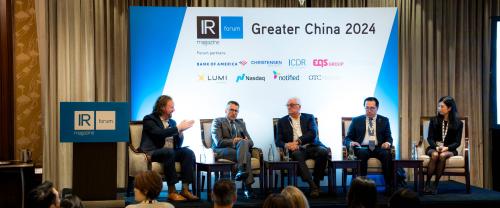
Mifid II is putting a lot of pressure on small and mid-cap IR teams due to the disruption the sell side has faced, according to Elena Basova, senior analyst at Nasdaq IR Intelligence.
‘Historically they were supported by the sell side, which scheduled buy-side meetings,’ she says. ‘Today, 50 percent less of those investor meetings are set up by the sell side than in early 2018. Now corporates are becoming increasingly responsible for engaging the buy side directly, ensuring transparency and liquidity. That means IROs have more responsibility, and management is watching more closely.’
To help, buy-side firms like Fidelity, Wellington and BlackRock, for example, are setting up corporate access teams, says Basova, while acknowledging that there is a gap in the market for small and mid-cap companies to fill.
‘But how do the IROs continue being on top of things and control the capital within their shareholdings while ensuring the inflow of additional pools of capital and making sure they get in front of the right buy-siders?’ she asks.
Basova says Nasdaq isn’t trying to replace banks or asset management firms, but notes that the stock exchange can help small and mid-cap corporates ‘to become more independent in covering the gap where they need to be on their own’ by providing specific tools, research, intelligence and advisory services.
Nasdaq will help corporates streamline the investor targeting process and post-earnings call activity. ‘We look at the beginning of the process, starting with searching for their top shareholder base and finding the right contacts and we finish by getting [them] in front of that [buy-side] person,’ Basova explains.
‘We have a variety of services that can help with that. We have Nasdaq IR Insight [a database tool], which provides intelligence so IROs can identify who’s good to talk to. [Within that] there is an Insight360 function, a target tracker that shows who has been buying and selling. You can pull up a certain event and see whether it resulted in a conversion or not.
‘We [provide full-year view] reports as part of our strategic capital intelligence service. Corporates can look back at the year [to identify] who it met with the most, what resulted in buying or selling, whether it covered its top 50 holders and how well it hit the top 100 targets.’
Noting that Nasdaq was proactive in planning for Mifid II business issues before the introduction of the regulation last January, Basova says the stock exchange’s approach is to provide small and mid-cap companies with a higher level of control and ability to better prioritize their C-suite time.
She concludes: ‘We will help these corporates to come up with a more surgical list of potential investors. This way they can strategically hit all the points they know investors are interested in. We also have the capability to drill down to the people level: we can recommend the person we think the company should be meeting with. Our advice is based on about 10-15 years of proprietary information of how those [buy-side] people have been investing.’










